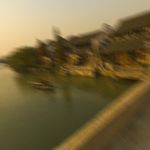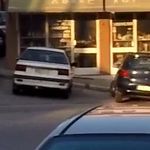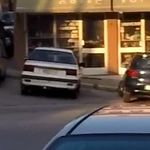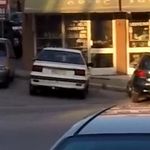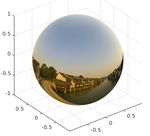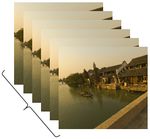Restoration of Video Frames from a Single Blurred Image with Motion Understanding
←
→
Page content transcription
If your browser does not render page correctly, please read the page content below
Restoration of Video Frames from a Single Blurred Image with Motion Understanding Dawit Mureja Argaw, Junsik Kim, Francois Rameau, Chaoning Zhang, In So Kweon KAIST Robotics and Computer Vision Lab., Daejeon, Korea arXiv:2104.09134v1 [cs.CV] 19 Apr 2021 Abstract methods deploy deblurring tasks with uniform-blur assump- tion, the assumption is often violated in practice. For in- We propose a novel framework to generate clean video stance, when the blur is caused by out-of-plane camera ro- frames from a single motion-blurred image. While a broad tation, the blur pattern becomes spatially variant. More- range of literature focuses on recovering a single image over, the problem is more complex when objects in a scene from a blurred image, in this work, we tackle a more chal- are moving i.e. dynamic blur. While previous literature fo- lenging task i.e. video restoration from a blurred image. cuses on recovering a sharp image from a blurred image, we We formulate video restoration from a single blurred image tackle a more challenging task i.e. video restoration from a as an inverse problem by setting clean image sequence and blurred image. their respective motion as latent factors, and the blurred Restoring the underlying image sequence of a blurred image as an observation. Our framework is based on an image requires both contents and motion prediction. We encoder-decoder structure with spatial transformer network formulate video restoration from a blurred image as an modules to restore a video sequence and its underlying mo- inverse problem where a clean sequence of images and tion in an end-to-end manner. We design a loss function and their motion as latent factors, and a blurred image as regularizers with complementary properties to stabilize the an observation. Some of previous deblurring approaches training and analyze variant models of the proposed net- [10, 33, 29, 27, 24, 1] also estimate the underlying motion in work. The effectiveness and transferability of our network a blurred image, however, their goal remains in single frame are highlighted through a large set of experiments on two restoration. Recently Jin et al. [13] proposed to extract different types of datasets: camera rotation blurs generated video frames from a single motion-blurred image. Their from panorama scenes and dynamic motion blurs in high approach is close to image translation model without infer- speed videos. ring underlying motions between the latent frames. Purohit et al. [26] addressed this issue by estimating pixel level motion from a given blurred input. However, their model 1. Introduction is still prone to sequential error propagation as frames are Capturing an image is not an instant process; to capture predicted in a sequential manner using a deblurred middle enough photons, the photosensitive elements of a camera frame. Our work differs from previous works in two as- have to be exposed to light for a certain interval of time, pects. First, we use a single network to restore the underly- called exposure time. Therefore, during this interval if an ing video frames from a single motion-blurred image in an object is moving in the observed scene or the camera is un- end-to-end manner while [13, 26] jointly optimize multiple dergoing an arbitrary motion, the resulting image will con- networks for the task. Second, our approach is not explic- tain a blurring artifact known as motion blur. In general, itly dependent on a deblurred middle frame in order to re- motion blur is an unwanted behaviour in vision applications store non-middle frames, and hence, is relatively robust to e.g. image editing [9], visual SLAM [16] and 3D recon- sequential error propagation which occurs due to erroneous struction [30], as it degrades the visual quality of images. middle frame. To cope with this type of artifact, image deblurring aims to In this paper, we propose a novel framework to gen- restore a sharp image from a blurred image. This problem erate a clean sequence of images from a single motion- is known to be ill-posed since the blur kernel used for de- blurred image. Our framework is based on a single encoder- convolution is generally assumed to be unknown. decoder structure with Spatial Transformer Network mod- Earlier studies assume a uniform-blur over the image to ules (STN) and Local Warping layers (LW) to restore an simplify the estimation of the single deconvolution blur ker- image sequence and its underlying motion. Specifically, a nel used to remove the blur [8, 5, 17]. Even though the single encoder is used to extract intermediate features which
are passed to multiple decoders with predicted motion from Sequence restoration from a blurred image. Recently, STN and LW modules to generate a sequence of deblurred Jin et al. [13] proposed to extract a video sequence from a images. We evaluate our model on two types of motion blur. single motion-blurred image using multiple deep networks. For rotation blur, which is caused by abrupt camera mo- They showed that deep networks can successfully generate tion, we generated a synthetic dataset from panoramic im- an image sequence from a blurred image, however there re- ages [11]. For dynamic blur caused by fast moving objects mains a few limitations. Their proposed framework consists in a scene, we used a high speed video dataset [20]. The of multiple networks of which each network is specialized proposed model is evaluated on the panorama and the high to predict a specific frame in a sequence. Each network is speed video datasets under various motion patterns. Both trained separately and sequentially starting from the middle the quantitative metrics and qualitative results highlight that frame and then adjacent frames taking previously predicted our method is more robust and performs favorably against frames as inputs. As a result, the non-middle frame predic- the competing approaches [13] We also provide comparison tion heavily relies on previously predicted frames including with single image deblurring approaches on GoPro bench- the middle frame itself, therefore when the middle frame mark dataset [20] to evaluate the performance of the middle is erroneous the error propagates across frames. Purohit et frame prediction. For further investigation, we demonstrate al. [26] proposed a two-step strategy to generate a video the transferability of our model by cross-dataset evaluation. from a motion-blurred image using three complementary In short, our contributions are as follows. 1) We propose networks. They used video autoencoder to learn motion and a novel unified architecture to restore clean video frames frame generation from clean frames as a pretraining phase. from a single motion-blurred image in an end-to-end man- Later, they introduced a motion disentangle network to ex- ner. 2) A simple yet effective mechanism is presented to tract motion from blurred image. They also used indepen- generate a realistic rotational blur dataset from panoramic dent deblurring network as their approach requires a clean images 3) We carefully design loss terms for stable network middle frame generated from a blurred image in advance. training and perform thorough experiments to analyze the Although their approach takes motion information into ac- transferability and flexibility of the proposed architecture. count, the approach generates frames sequentially starting 4) Our model quantitatively and qualitatively performs fa- from the middle frame to adjacent frames which results in vorably against the competing approaches. error propagation just as in [13]. Unlike the previous works, our approach runs in an end-to-end manner within a single 2. Related Works training stage without error propagation across frames. Image deblurring. Image deblurring is an ill-posed in- verse problem when a blur kernel is unknown i.e. blind 3. Dataset deconvolution problem, as different latent images can be Collecting a large number of natural motion-blurred im- transformed to a blurred image depending on its blur kernel. ages is a daunting task. Hence, a common practice in com- Early stage of deblurring studies [5, 8, 22, 19, 23, 4, 7, 32] puter vision research is to generate blurry images by com- assume a single blur kernel that is applied to an image glob- bining a sequence of sharp images using various approaches ally. The restoration of blur images is often modeled as a ranging from simple averaging [20, 13] to learnable meth- maximization problem of probabilistic models [5, 8]. To ods [3]. The source of motion blur in an image can be gener- narrow down the ambiguity of the blur kernel estimation, alized into two main categories: rapid camera motion (cam- natural image priors [19, 22, 23, 32] are exploited. While era shake) and dynamic motion of objects in the scene. In single blur kernel estimation approaches are effective when this section, we briefly explain how we generate a blurry blur kernels are shift-invariant, they fail when the blur is image dataset by considering each case individually. not spatially uniform. To restore images affected by motion blur from pure rotations, Dong et al. [7] use the geomet- Rotational blur (synthetic). In order to generate a rota- ric information of the camera motion as a prior to recover tion blurred image dataset, we use the SUN360 panorama the non-uniform blur model. Recently, deep network based dataset [11]. This dataset provides various panoramas with methods [20, 34] are proposed to handle general blur pat- 360◦ field of view. Hence, a virtual camera can be mod- terns without the uniform blur assumption. Nah et al. pro- eled to point at different orientations to represent the cam- pose multi-scale deep networks with multi-scale loss that era rotation in SO(3). Given a panorama P of size H × W , mimics coarse-to-fine approaches to restore sharp images we developed a simple yet effective framework to generate under non-uniform blurred images. Zhang et al. proposed blurred images. First, the panorama is projected onto a unit a spatially variant neural networks to learn spatially vari- sphere by linearly mapping each pixel coordinate (x, y) ∈ ant kernels. However, the approaches addressed here only P into spherical coordinates (θ, φ) with θ ∈ (0, 2π) and recover a single image while our goal is to recover the un- φ ∈ (−π/2, π/2). Then, a synthetic image can be cap- derlying sequence of frames from a given blurred image. tured via a virtual camera by re-projecting the 3D points on 2
(a) (b) (c) (d)
Figure 1: Rotational blur dataset generation. (a) input panorama image, (b) panorama projection on a unit sphere, (c)
intermediate frames between the initial and final images (d) blurred image obtained by averaging the captured frames.
the sphere into an image plane as briefly discussed in [18] tent frame Im . In this work, we restore the entire latent
and [21]. Using this procedure we first capture an image frame sequence {Im− n2 , . . . , Im−1 , Im , Im+1 , . . . , Im+ n2 },
by positioning the virtual camera at an arbitrary orientation. m+ n
where Im is the deblurred middle frame and {Ij }j=m− 2
n
We call the image generated at this orientation initial image. where j 6= m are the recovered non-middle latent frames.
2
Then, we rotate the camera by a random rotation matrix The input blur is used as a motion cue to decode non-
(with β = (βx , βy , βz ) its Euler angle representation) and middle latent frame features (with respect to the middle la-
capture a second image at the new camera position called tent frame) using transformer networks as shown in Fig. 2.
final image. We finally use a quaternion spherical linear in-
terpolation technique (Slerp) [6] to 4.1. Middle latent frame
capture intermediate frames between the initial and fi-
The middle latent frame Im is reconstructed using a U-
nal images. All the resulting images (initial, final and in-
net [28] like network. The encoder contains five convolu-
termediate frames) are then averaged to generate a blurry
tional blocks, each block containing two layers of convolu-
image. The camera rotation angle is uniformly sampled
tions with spatial kernel size of 3 × 3 and stride size of 2
from [−10◦ , 10◦ ]. In order to generate a realistic blurred
and 1, respectively. It outputs encoded features at different
image, the number of intermediate images have to be ad-
feature levels as shown in Fig. 2a. The encoded features are
justed automatically depending upon the rotation magni-
then decoded to predict the middle latent frame. The mid-
tude between the initial and final frames. Therefore, we use
dle frame decoder network also contains five convolutional
a simple linear relationship between the number of frames
blocks to upsample features and to predict images at differ-
to be generated (n) and the rotation magnitude as follows:
ent scales. In each block, a feature is first upscaled using
n = c + 31 kβk, where c is a constant and kβk is the mag-
a deconvolution layer of kernel size 4 × 4 and a stride size
nitude of β. In this manner, we use 1000 panoramic images
of 2. The image predicted in the previous block is also up-
from which we generate 26, 000 training and 3, 200 test im-
scaled in the same manner. The upsampled feature and its
ages of size 128 × 128px. The dataset generation process is
respective image are then concatenated channel-wise with
summarized in Fig. 1.
the corresponding feature from the encoder (skip connec-
Dynamic motion (real). In order to generate more real- tion as shown in the Fig. 2a), then passed through five layers
istic and generic (arbitrary camera motions and dynamic of convolutions with dense connections to output a feature,
scene) blurred images, we take advantage of a GoPro high which will be used to predict an image at current block. In
speed video dataset [20]. This dataset provides 22 train- this manner, features and images are successively upsam-
ing and 11 test scenes, each scene containing frames of size pled to predict a full scale middle frame. Along with the last
1280 × 720px. A blurry image is generated by averaging n feature map from the decoder, the predicted image is finally
consecutive frames [20, 13]. In our experiments, we fixed passed through a refining convolutional block. The purpose
n = 7 and generated 20, 000 training images by randomly of this network is to further refine the predicted frame with
cropping images of size 256 × 256px. We also generated contextual information by effectively enlarging the recep-
2000 test images from the test videos by averaging 7 con- tive field size of the network.
secutive frames. 4.2. Non-middle latent frame
4. Method The non-middle latent frames are reconstructed from
the encoded features via learned transformations by feature
Given a blurry image Ib synthesized from averaging n transformer networks (FTN) and image transformer net-
latent frames, deblurring approaches predict the middle la- works (ITN) as shown in Fig. 2b.
3Feature Transformer Network
FTN
FTN −
FTN 2
FTN ITN LW STN
STN
…
ITN
ITN
Image Transformer Network
ITN
ITN
ITN
ITN
…
FTN
FTN
FTN
STN LW STN
Encoder features
Middle frame decoder features
Non-middle frame decoder features
Refining block
Convolutional layers +
2
Channel-wise concatenation
Skip connection (a) (b)
Figure 2: Overview of our network. (a) The middle frame is predicted using an encoder-decoder structure. The non-middle
frames are reconstructed by transforming the multi-layer features of the middle frame. (b) Feature transformer network (FTN)
transforms features locally via local warping (LW) and globally via spatial transformer network (STN). Image transformer
network (ITN) transforms predicted middle frame via STN. Finally, the predicted frames are passed through a refining
network.
Feature transformer network. The feature transformer the estimated middle frames according to the learned inter-
network inputs an encoded feature and transforms it into frame motion i.e. Itl = STN(Im l
), where Im is the predcited
a non-middle latent feature in accordance with the learned middle frame and It is the transformed image (see Fig. 2b).
motion. It consists of spatial transformer network (STN) FTNs decode non-middle latent features from encoded
[12] and local warping (LW) layer. The STNs learn to esti- features via learned local and non-local motions while ITNs
mate global transformation parameter θ[R|T ] from encoded globally capture the motion of the non-middle latent frame
features of a motion-blurred input and transform them ac- relative to the middle latent frame. The outputs of both net-
cordingly. In order to compensate for locally varying mo- works are aggregated channel-wise and are passed through a
tions, we designed a local warping network. This network is decoder to predict a non-middle frame (Fig. 2b). We also in-
conditioned on the input feature like STN, however, instead put the encoded feature into the non-middle frame decoder
of predicting global transformation parameters, it predicts in order to guide the decoder to learn the spatial relation
pixel-wise displacement i.e. motion flow. Given an input between the middle and the non-middle frame as shown
feature U ∈ RH×W ×C , the local warping network outputs Eq. (2).
a motion flow of size H × W × 2. By warping the input Ipl = Dl (Utl ⊕ Itl ⊕ Uel ) (2)
feature with the predicted motion flow, we obtain a locally
transformed feature which is concatenated with the globally where p = {m − n2 , . . . , m − 1, m + 1, . . . , m + n2 } is an
transformed feature as shown in Eq. (1). index for non-middle latent frames and D is a non-middle
frame decoder.
Utl = STNl (Uel ) ⊕ LWl (Uel ), (1) Given ground truth non-middle frames during training,
where l = {1, ... , k} is an index for k feature levels, Ue is our model learns the transformation parameters to be ap-
an encoded feature and Ut is a transformed feature. plied to the encoded features of a blurry input at different
scales in order to output the desired non-middle frames. The
Image transformer network. The middle frame decoder fact that unique transformer networks are applied at each
predicts frames at different feature levels. To guide the re- feature and image scale gives the model a capacity to learn
construction of the non-middle latent frames with respect various types of transformations, hence, making it robust to
to the middle frame, we used STNs to spatially transform different blur patterns including large blurs.
44.3. Loss functions the middle frame) ground truth frame. For example, when
To ensure stable training and to restore clean latent frame predicting seven frames {I1 , ..., I4 , ...., I7 }, we enforce the
sequences in a temporally coherent manner, we carefully predicted image I1 to be different content-wise from the
designed the following loss functions, ground truth image I7 and vice versa. The penalty is im-
posed in a symmetric manner (as a matter of design choice
Photometric loss. For sharp video frame reconstruction, inspired by the network architecture) such that the model
we trained our network with a weighted multi-scale pho- learns to be sensitive to smaller transformations close to the
tometric loss between the images predicted by the decoder middle frame as well as larger transformations at the end
network and the ground truth image. A bilinear downsam- frames. Given a predicted frame ŷi and the corresponding
pling is used to resize the ground truth image to the cor- time-symmetric ground truth yn+1−i , the penalty term is
responding predicted frame size at different scales. Let computed as the term Lp in Eq. (5),
{ŷ}kl=1 denote a set of predicted images from the small- where m is the middle frame index, n is the total number
est size (ŷ1 ) to the full scale (ŷk ), and {y}kl=1 represent a of frames.
n
set of downsampled ground truth images where yk is a full X
Lp = − yn+1−j − ŷj 1 (5)
scale ground truth image. For training a model predicting
j=1,j6=m
a sequence with n frames from a single blurry image, we
compute multi-scale photometric loss as follows, The final training loss function is defined as follows,
k
n X
L = Lmp + λtc Ltc + λp Lp , (6)
X
Lmp = wl · yj,l − ŷj,l 1
(3)
j=1 l=1
where λtc and λp are weight coefficients for transformation
where wl is the loss weight coefficient for feature level l consistency loss and penalty term, respectively.
and j is an index for frame sequence.
Temporal ambiguity and network training. The task at
Transformation consistency loss. We used individual hand has two main ambiguities. i. temporal shuffling and ii.
transformer networks at each feature level when predicting reverse ordering. As explained in section 3, motion-blur is
non-middle frames. This augments our model with the ca- the result of an averaging process and, restoring temporally
pacity to learn transformations at different levels making consistent (no shuffling) sharp frame sequence from a given
it robust to various blur patterns. However, we expect the motion-blurred input is a non-trivial task as the averaging
transformations at different scales to be aligned for suc- destroys the temporal order. Jin et al. [13] mentions that
cessfully reconstructing temporally consistent non-middle photometric loss is not a sufficient constraint to make their
frames. Especially at the initial stages of the training where network converge. Hence, they propose a pair-wise order
the transformer parameters are random, it is beneficial that invariant loss to train their network. Purohit et al. [26] also
our model understands the relationship between the trans- uses the same loss function to fine-tune the recurrent video
formations across different frame levels. In order to impose decoder in their network.
this notion into our model and facilitate a smooth training, We experimentally find that a multi-scale photometric
we propose the transformation consistency loss. Let {θ}kl=1 loss is a sufficient constraint to train our network. We fur-
be the set of predicted transformation parameters at differ- ther impose more constraints using other loss terms to im-
ent scales. The transformation consistency loss for predict- prove performance (see Ablation studies). By design na-
ing n − 1 non-middle frames can be defined as the term Ltc ture, our model allows motions to be learned in a symmetric
in Eq. (4), manner (about the middle frame) with transformer networks
where |.|2 is an `2 loss between the transformation pa- close to the middle frame decoding smaller motions and
n−1 k
rameters. XX those further from the middle frame decoding larger mo-
Ltc = θ j,l − θ j,l−1 2 (4)
tions. This notion is enforced by symmetric constraint term
j=1 l=2
and transformation consistency loss during training. The
Penalty term. Predicting multiple frames from a single fact that our model is optimized in a joint manner allows
blurry image can be problematic at times when the model frames to be reconstructed in a motion-guided sequence.
fails to learn any type of transformation and simply repli- Other than temporal shuffling, another issue is reverse
cates the middle frame predicition as non-middle frames. ordering. Given a single motion-blurred input, recover-
In order to remedy this issue, we design a penalty term to ing ground truth order is a highly ill-posed problem which
enforce symmetric diversity among generated images. This is intractable since reversely ordered frames result in the
is accomplished by explicitly maximizing the sum of abso- same motion-blurred image. Neither our work nor previ-
lute difference (SAD) i.e. minimizing the negative SAD ous works [13, 26] are capable of predicting the right or-
between a predicted frame and its time-symmetric (about der. Hence, we evaluate frame reconstructions using both
5Table 1: Quantitative evaluation on Panorama blur dataset Table 2: Quantitative evaluation on GoPro blur dataset
Methods Fi Fm Ff Methods Fi Fm Ff
PSNR Jin et al. 22.007 22.493 22.157 PSNR Jin et al. 23.713 29.473 23.681
Ours 23.693 24.049 23.874 Ours 27.357 31.989 27.414
SSIM Jin et al. 0.572 0.621 0.589 SSIM Jin et al. 0.660 0.846 0.659
Ours 0.699 0.716 0.704 Ours 0.794 0.885 0.793
In contrast, the GoPro blur dataset, however, contains ar-
ground truth order and its reverse order, then report the bitrary camera motions with dynamic scene and hence, de-
higher metric in the experiment section. A recent work by coding frames require inferring non-uniform global and lo-
Argaw et al. [2] proposed an optical flow based approach cal motions between frames (with middle frame as a refer-
to reconstruct sharp frames in a temporally ordered manner, ence). Therefore, the network reliably performs for mid-
however, their approach requires at least two blurry frames. dle frame prediction and performs less for the end frames
5. Experiment due to randomness of motions (see Table 2). On GoPro
blur dataset, our model outperforms Jin et al. by 2.51 dB
Implementation details Our model is implemented using on middle frame prediction and by 3.69 dB on non-middle
PyTorch [25]. We chose Adam [14] as an optimizer with β1 frame predictions. This highlights the advantage of adopt-
and β2 fixed to 0.9 and 0.999, respectively. On our synthetic ing a motion-based approach to leverage blur as a motion
blur dataset, we train the model using images of size 128 × cue to decode latent frames rather than extracting frames
128px and a mini-batch size of 8 to predict initial, middle sequentially in a generic manner.
and final frames. A mini-batch size of 4 and input size of The performance gap between the middle frame and non-
256 × 256px is used to predict sequences of frames when middle frames is relatively larger in Jin et al. than our
training on the high speed video dataset. In all experiments, method. This is due to sequential prediction in Jin et al.
we train our model for 80 epochs. We set the learning rate which makes non-middle frame prediction heavily depen-
λ = 1e − 4 at the start of the training and decay it by half at dent on the generated middle frame, resulting in error prop-
epochs 40 and 60. All the training images are cropped from agation. As stated in [13], this limitation is particularly
the original resolution images without resizing. problematic when a heavy blur affects the input image since
5.1. Video restoration results the middle frame prediction becomes less reliable. Our ap-
proach is relatively robust to heavy blur as the proposed
In this section, we analyze the performance of our model generates frames independently from multiple de-
model for sequential frame restoration qualitatively and coders, therefore the error is not propagated (see Fig. 7).
quantitatively on both camera shake blurs generated from We observed lower quantitative number in panorama sce-
panoramic scenes and dynamic blurs obtained from high nario compared to the high speed video for both Jin et al.
speed videos. and our model. This is most likely because panorama GT
images are relatively sharper while high speed video con-
Quantitative evaluation. We report test results using tains less sharp GT frames due to dynamic motion and short
peak signal-to-noise ratio (PSNR) and structural similarity exposure time.
(SSIM) metrics. To purely evaluate the quality of gener-
ated images without ordering estimation issue due to re- Qualitative evaluation. The qualitative results for
verse ordering, we report the higher PSNR/SSIM metric panoramic scenes and high speed videos show that our
of either ground truth order or reverse order of frames i.e. model can successfully restore multiple frames from a
max{PSNR/SSIM(Fi → Ff ), PSNR/SSIM(Ff → Fi )}, blurred input under various blur patterns (see Fig. 3 and
where Fi , Fm and Ff refer to the initial, middle and final Fig. 4). We compare our approach and previous method
frames in the restored sequence, respectively. We compared [13] on relatively heavily blurred images from the high
our approach with previous works [13] on both rotational speed video dataset. As can be seen from Fig. 4, our
and dynamic blur datasets as tabulated in Table 1 and Ta- method reconstructs contents consistently across frames
ble 2. On Panorama blur dataset, our model outperforms Jin and restores visually sharper videos compared to [13].
et al. by 1.65 dB on average. The middle and non-middle We experimentally observed that failure cases occur for
frame accuracy are similar on average (see Table 1) mainly temporally undersampled and severely blurred inputs (see
because rotational blurs are static blurs with uniform cam- Fig. 5). The image contents of such inputs are usually
era motion. Hence, it is relatively easier for the network destroyed, and hence, the STNs [12] and the LW layers in
to infer the global motion and decode frames accordingly. our network fail to learn the underlying motion from the
6Input Fi Fm Ff Input Fi Fm Ff GT Ours Figure 3: Rotation blurred images generated from panorama scenes. The top row is ground truth frames and the bottom row is restored frames from the blurs. Input GT Jin et al. Ours Input GT Jin et al. Ours Figure 4: Heavily blurred (dynamic) inputs from the high speed videos and the restored video frames. Click on the images in Adobe Reader to play the videos. heavily blurred inputs i.e. feature decoding fails. Input Fi Fm Ff 5.2. Middle frame deblurring results In addition to video restoration, we evaluate the per- formance of our model on image deblurring task in com- parison with state-of-the-art image deblurring approaches [20, 15, 31] on a benchmark blur dataset provided by [20]. The dataset provides 1111 test blurred images with 1280 × 720px resolution. We compared the middle frame prediction (Fm ) of our pretrained 7-frame prediction model with state-of-the-art deblurring approaches and the results are summarized in Table 3. As can be inferred from Ta- ble 3, our video restoration model gives a competitive per- Figure 5: Failure cases formance on image deblurring task compared to state-of- the-art deblurring approaches. The slight performance loss eralization capability of our model. A model trained on the can be attributed to the fact our model was trained on blur panoramic scenes is evaluated on high speed video test set dataset generated by averaging 7 frames while the bench- (Table 4). Despite a performance degradation, our model mark dataset contains blurred images obtained by averaging trained on the panorama dataset performs on par with the more than 7 sequential frames (larger blurs). competing approach [13] trained on the high speed video dataset. The absence of dynamic motion on the panorama Table 3: Middle frame deblurring comparison with deblur- dataset, which is apparent in high speed videos, can be one ring approaches on benchmark GoPro blur dataset [20] on contributing factor explaining the performance loss in ad- PSNR metric. dition to the domain gap e.g. image contents, sharpness, Single image deblurring Video restoration blurriness. Nah et al. Kupyn et al. Tao et al. Jin et al. Ours 29.08 28.70 30.26 26.98 29.84 Size of blur. We analyze our model for various blur sizes by plotting the performance of the model with respect to 6. Analysis the camera rotation magnitudes of the blurred images in the Cross-dataset evaluation. We report a cross-dataset panorama test set. As can be inferred from Fig. 6, the model panorama→high speed video evaluation to assess the gen- performs better for smaller rotations and performance in 7
general decreases for large blurs. Input Fi Fm Ff Sequential error propagation. Previous works [13, 26] Jin et al. are prone to error propagation as frames are reconstructed in a sequential manner starting from the middle frame. Partic- ularly, if the deblurred middle frame is erroneous, then, the error propagates across the non-middle frames. Our work is relatively robust to sequential error propagation since all Ours frames are predicted in a single-step without explicit middle frame dependency, hence, error does not propagate. As can be inferred from Fig. 7, for heavily blurred inputs, Jin et al. predicts erroneous middle frame and hence, the predicted non-middle frames are also erroneous. By contrast, our ap- Figure 7: Sequential error propagation proach successfully recovers non-middle frames even when the middle frame prediction fails. Table 5: Ablation studies on GoPro blur dataset for network components and loss terms on PSNR metric. Fi Fm Ff FTN [STN] 25.86 31.20 25.78 Network FTN [STN ⊕ LW] 26.67 32.02 26.58 components FTN [STN] ⊕ ITN 26.06 31.78 26.05 FTN [STN ⊕ LW] ⊕ ITN 27.35 31.98 27.41 PML 25.98 30.77 25.97 Loss terms PML ⊕ TCL 27.08 31.78 27.12 PML ⊕ TCL ⊕ PT 27.35 31.98 27.41 term (PT) gives a marginal performance improvement when predicting fewer frames as photometric loss is already a suf- ficient constraint (see Table 5). In 3 frame prediction model, Figure 6: PSNR value vs. camera rotation magnitude for the penalty term improved performance marginally around panorama test set 0.25dB while in 7 frame prediction model, it improved ap- proximately 0.6dB. Penalty term enforces the model to con- Table 4: Quantitative results for cross-dataset evaluation sider subtle differences especially when the motion is small. Panorama→ high speed 8. Conclusion Fi Fm Ff We present a novel unified architecture that restores PSNR 23.383 30.300 23.380 video frames from a single blurred image in an end-to-end SSIM 0.649 0.832 0.651 manner without motion supervision. We evaluate our model on the two datasets with rotation blurs and dynamic blurs 7. Ablation studies and demonstrate qualitatively and quantitatively favorable performance against the competing approach. The cross- Network components. The STNs in the feature trans- dataset evaluation demonstrates that our model can gener- former network are the core part of our model for network alize even when the training and test set have significantly convergence. The addition of local warping (LW) layer also different blur patterns and domain gap. Unlike the previous significantly improves the performance of our model. The approaches, our model predicts frames in a single step with- best model performance is, yet, achieved with the all net- out middle frame dependency. It is advantageous not only work components (FTN and ITN) combined (Table 5). The because it is simple to use but also robust to heavy blurs refining block improves performance by a margin of 0.43 where middle frame prediction often fails. Overall, the sim- dB on average. plicity and flexibility of our method makes it a promising approach for future applications such as deblurring and tem- Loss terms. As mentioned earlier, the multi-scale photo- poral super resolution. metric loss (PML) is a sufficient constraint to make our net- work converge during training. We also experimentally find that a model trained with transformation consistency loss Acknowledgements. This work was supported by (TCL) not only converges faster with smoother behavior but NAVER LABS Corporation [SSIM: Semantic & scalable also gives a better performance during testing. The penalty indoor mapping]. 8
References [18] Christopher Mei and Patrick Rives. Single view point omni- directional camera calibration from planar grids. In IEEE In- [1] Dawit Mureja Argaw, Junsik Kim, Francois Rameau, ternational Conference on Robotics and Automation (ICRA), Jae Won Cho, and In So Kweon. Optical flow estimation 2007. from a single motion-blurred image. In AAAI Conference on [19] Tomer Michaeli and Michal Irani. Blind deblurring using Artificial Intelligence, 2021. internal patch recurrence. In European Conference on Com- [2] Dawit Mureja Argaw, Junsik Kim, Francois Rameau, and puter Vision, 2014. In So Kweon. Motion-blurred video interpolation and ex- [20] Seungjun Nah, Tae Hyun Kim, and Kyoung Mu Lee. Deep trapolation. In AAAI Conference on Artificial Intelligence, multi-scale convolutional neural network for dynamic scene 2021. deblurring. In IEEE Conference on Computer Vision and [3] Tim Brooks and Jonathan T. Barron. Learning to synthesize Pattern Recognition, 2017. motion blur. In IEEE Conference on Computer Vision and [21] Bogdan Oleksandr, Eckstein Viktor, Rameau Francois, and Pattern Recognition, 2019. Bazin Jean-Charles. Single view point omnidirectional cam- [4] Ayan Chakrabarti. A neural approach to blind motion deblur- era calibration from planar grids. In ACM SIGGRAPH Euro- ring. In European Conference on Computer Vision, 2016. pean Conference on Visual Media Production, 2018. [5] Sunghyun Cho and Seungyong Lee. Fast motion deblur- [22] Jinshan Pan, Zhe Hu, Zhixun Su, and Ming-Hsuan Yang. De- ring. ACM Transactions on Graphics (Proceedings of SIG- blurring text images via l0-regularized intensity and gradient GRAPH), 28(5):145, 2009. prior. In IEEE Conference on Computer Vision and Pattern [6] Erik B. Dam, Martin Koch, and Martin Lillholm. Quater- Recognition, 2014. nions, interpolation and animation. In Technical Report [23] Jinshan Pan, Deqing Sun, Hanspeter Pfister, and Ming- DIKU-TR-98/5, pages 42–48, 1998. Hsuan Yang. Blind image deblurring using dark channel [7] Jiangxin Dong, Jinshan Pan, Zhixun Su, and Ming-Hsuan prior. In IEEE Conference on Computer Vision and Pattern Yang. Blind image deblurring with outlier handling. In IEEE Recognition, 2016. International Conference on Computer Vision, 2017. [24] Haesol Park and Kyoung Mu Lee. Joint estimation of camera [8] Rob Fergus, Barun Singh, Aaron Hertzmann, Sam T Roweis, pose, depth, deblurring, and super-resolution from a blurred and William T Freeman. Removing camera shake from a sin- image sequence. In IEEE International Conference on Com- gle photograph. ACM Transactions on Graphics (Proceed- puter Vision, 2017. ings of SIGGRAPH), 25(3):787–794, 2006. [25] Adam Paszke, Sam Gross, Soumith Chintala, Gregory [9] Bahadir Kursat Gunturk and Xin Li. Image restoration: fun- Chanan, Edward Yang, Zachary DeVito, Zeming Lin, Al- damentals and advances. CRC Press, 2012. ban Desmaison, Luca Antiga, and Adam Lerer. Automatic [10] Tae Hyun Kim and Kyoung Mu Lee. Segmentation-free dy- differentiation in pytorch. NIPS-W, 2017. namic scene deblurring. In IEEE Conference on Computer [26] Kuldeep Purohit, Anshul Shah, and AN Rajagopalan. Bring- Vision and Pattern Recognition, 2014. ing alive blurred moments. In Proceedings of the IEEE Con- [11] A. Oliva J. Xiao, K. A. Ehinger and A. Torralba. Recogniz- ference on Computer Vision and Pattern Recognition, pages ing scene viewpoint using panoramic place representation. 6830–6839, 2019. In IEEE Conference on Computer Vision and Pattern Recog- [27] Wenqi Ren, Jinshan Pan, Xiaochun Cao, and Ming-Hsuan nition, 2012. Yang. Video deblurring via semantic segmentation and pixel- [12] Max Jaderberg, Karen Simonyan, Andrew Zisserman, et al. wise non-linear kernel. In IEEE International Conference on Spatial transformer networks. In Advances in Neural Infor- Computer Vision, 2017. mation Processing Systems, 2015. [28] Olaf Ronneberger, Philipp Fischer, and Thomas Brox. U- [13] Meiguang Jin, Givi Meishvili, and Paolo Favaro. Learning net: Convolutional networks for biomedical image segmen- to extract a video sequence from a single motion-blurred im- tation. In International Conference on Medical image com- age. In IEEE Conference on Computer Vision and Pattern puting and computer-assisted intervention, 2015. Recognition, 2018. [29] Anita Sellent, Carsten Rother, and Stefan Roth. Stereo video [14] Diederik P. Kingma and Jimmy Ba. Adam: A method deblurring. In European Conference on Computer Vision, for stochastic optimization. In International Conference on 2016. Learning Representations, 2015. [30] Hee Seok Lee and Kuoung Mu Lee. Dense 3d reconstruction [15] Orest Kupyn, Volodymyr Budzan, Mykola Mykhailych, from severely blurred images using a single moving camera. Dmytro Mishkin, and Jiri Matas. Deblurgan: Blind motion In IEEE Conference on Computer Vision and Pattern Recog- deblurring using conditional adversarial networks. ArXiv e- nition, 2013. prints, 2017. [31] Xin Tao, Hongyun Gao, Xiaoyong Shen, Jue Wang, and Ji- [16] Hee Seok Lee, Junghyun Kwon, and Kyoung Mu Lee. Si- aya Jia. Scale-recurrent network for deep image deblurring. multaneous localization, mapping and deblurring. In IEEE In IEEE Conference on Computer Vision and Pattern Recog- International Conference on Computer Vision, 2011. nition (CVPR), 2018. [17] Anat Levin, Yair Weiss, Fredo Durand, and William T Free- [32] Yanyang Yan, Wenqi Ren, Yuanfang Guo, Rui Wang, and man. Understanding and evaluating blind deconvolution al- Xiaochun Cao. Image deblurring via extreme channels prior. gorithms. In IEEE Conference on Computer Vision and Pat- In IEEE Conference on Computer Vision and Pattern Recog- tern Recognition, 2009. nition, 2017. 9
[33] Haichao Zhang and Jianchao Yang. Intra-frame deblurring by leveraging inter-frame camera motion. In IEEE Confer- ence on Computer Vision and Pattern Recognition, 2015. [34] Jiawei Zhang, Jinshan Pan, Jimmy Ren, Yibing Song, Lin- chao Bao, Rynson W.H. Lau, and Ming-Hsuan Yang. Dy- namic scene deblurring using spatially variant recurrent neu- ral networks. In IEEE Conference on Computer Vision and Pattern Recognition, 2018. 10
You can also read

